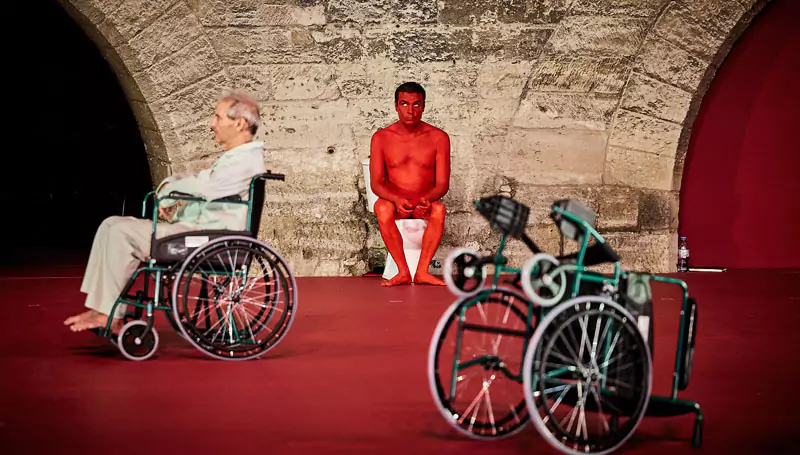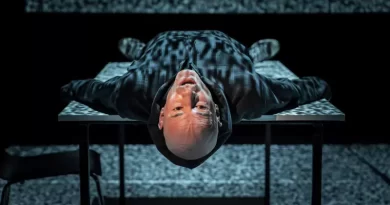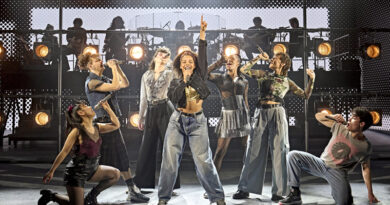Festival d’Avignon
Robert Schneider in France
8 July 2024
Angelica Liddell’s Dämon: Ingmar Bergman’s funeral
A long file of wheelchairs waits stage left. A pope enters wearing a white cassock. He counts the wheelchairs and wanders out. A dwarf enters, his face made up like a skull. He stands for a long moment centre stage. Four young men in black escort the dwarf out. Everything happens quite slowly—is it to ratchet down our expectations? Author/director Angelica Liddell enters, naked except for an open robe. She sets up a bidet centre stage, faces upstage to wash her vagina, then takes the basin and throws the water against the wall of Avignon’s fourteenth-century Papal Palace. Is it to ratchet up our outrage?
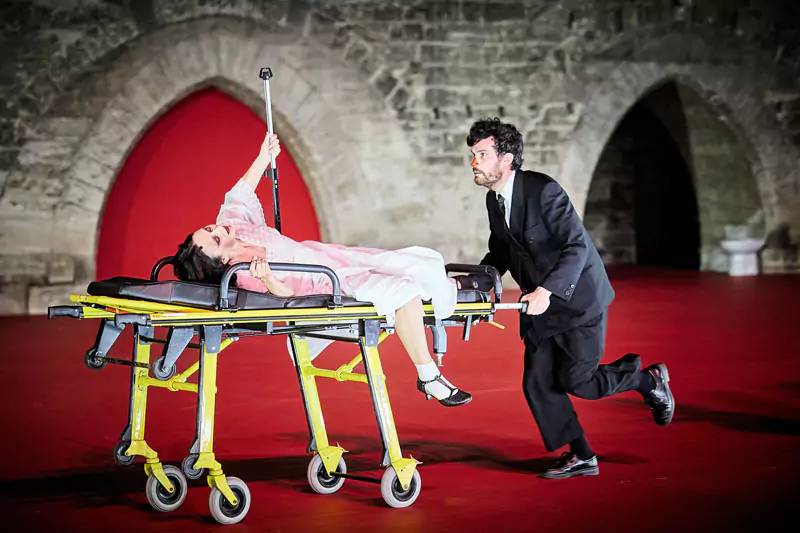
DÄMON El funeral de Bergman.
Photo credit: Christophe Raynaud de Lage.
The provocation continues when Liddell takes a microphone and launches into an hour-long screed using the most profane language possible to describe her critics, her audience and the bitterness of life itself. Excrement and blood are frequently mentioned, together with their associated verbs. Audience members who don’t understand Spanish read the supertitles projected on the palace in French and English. She quotes unfavourable reviews of her past shows; names the critic and then shouts, “Where are you, [name of critic]?”
That a mature theatre artist, naked or not, spends 40 percent of her new show calling out her critics bespeaks peevishness and a towering ego. The first part of Dämon: the funeral of Ingmar Bergman is the most off-putting thing I’ve seen on stage since Karen Finley’s Shock Treatment. If I gave you direct quotes, you would get the full flavour of this diatribe, but why turn off my readers just because Liddell so energetically turns off her audience? Carping at us, we who are all but captive in our seats? Attacking us in the guise of defending herself? Complaining (to a full house in the cour d’honneur at Avignon) that she’s not properly appreciated?
She’s entitled to critique the nasty business of living, of course, as Beckett and Bernhard critiqued it so eloquently in the last century. But why from the stage? Can’t she find a less expensive pulpit? Or simply put out a blog?
After nearly an hour of this, some audience members start to leave. This proves to be a mistake because things are about to get interesting. The windows of the Papal Palace light up. We hear singing. The dwarf, his face painted red, appears in an upper window and sits in the sill, 15 metres above the stage. Young women in white, gauzy gowns appear in an archway ornamented with gothic tracery. A dozen or more extras, elderly men and women recruited from a retirement home, enter wearing hospital sleepwear. They unlock the wheelchairs and stand behind them. The pope reappears, as does an elderly man, naked except for a black arm band, shouting incoherently at the young men in black.
A hospital gurney appears. The young men in black form a relay team to push the gurney. Angelica Liddell runs around the vast stage a dozen times pursued by the gurney. The symbolism isn’t subtle, but the workout is impressive: she’s running hard and being chased by four men half her age. There’s stamina in Liddell’s legs and lungs as well as her voice and sense of grievance.
A child of about nine is brought on. She’s ceremonially blindfolded and guided to one of the wheelchairs. The young women reappear, naked beneath the gauzy robes that the dying Mistral blows away from their bodies. One of the elderly women, naked now, plays dead on the gurney, her cadaver examined by the pope and the young men in black. (We now know why the child is blindfolded.)
The post-mortem examination becomes a ballet: the child and the elderly extras are wheeled here and there in close-order drill before forming a line upstage, facing out. The young women disrobe entirely and go down the line of wheelchairs, striking poses beside or in front of each cast member. The poses are coded to be arousing but the eroticism is lost in the swirl of morbid images. The young men in black take down their trousers. They moon the audience or attempt to masturbate. Liddell is still nearly naked. As the wind blows through the cour d’honneur, I wonder idly if the performers won’t catch cold.
Such is Dämon. The title means “demons” in Swedish and refers to every weakness, indulgence or depravity that haunts Liddell (and humans generally) and keeps us from living consistently wholesome and productive lives. Curiously for a Spanish artist, Liddell appears haunted by Calvinist demons.
This wordless second act is rich and satisfying. Childhood, maturity and decline are all present, neither acted nor indicated, but simply and insistently present. Eros and Thanatos have their say. The spectacle exposes the plenitude of human experience without separating the parts. It doesn’t blush or act coy. It feels little need to entertain, presenting its findings cooly but with a grain of manic joy. The blending of the beautiful and the grotesque warranties the show’s completeness. I’m happy I stayed.
To an interviewer from Le Monde, Liddell said: “The stage is the only place where I take risks. On stage, I live a crazed life, a kind of controlled madness, but behind this, I’m still thinking about art. For me, defending art means going through a state of self-destruction and a yearning for annihilation.” She confesses she needs to be constantly working to keep her inner demons at bay. She quotes Ingmar Bergman saying that his inner demons always dragged battle tanks behind them.
Now follows the third act, a burlesque reproduction of Bergman’s funeral based on the Swedish director’s detailed notes for the same. This includes a dialog from Strindberg’s A Dream Play (one of Bergman’s favourites) presented in Swedish. Strindberg was famously haunted by his personal demons and felt a similar need to exorcise them in his work which Liddell now quotes.
Once Bergman’s coffin is brought out—Bergman modelled it on the coffin of Jean-Paul II—the production works even harder at cross purposes. When the pastor leads the congregation in the Lord’s prayer (in Swedish), she’s all but drowned out by ambulance sirens. A Bach cello sonata (the one Bergman wanted played at his funeral) is chopped up by the sound of a helicopter rendered so realistically that audience members looked up, expecting to see one hovering overhead.
Liddell’s clashing aesthetics—sacred texts colliding with carnality, beautiful bodies and beautiful things all but devoured by brutality—make more sense (or at least acquire more depth) if we consider that Liddell reconfigures Bergman’s funeral in anticipation of her own.
The programme informs us that the naked young women and masturbating men are students at the Royal Swedish Academy of Dramatic Art. For that reason (and to better hear her master’s voice) Liddell brought her company to Stockholm to rehearse in Bergman’s old theatre, the Dramaten.
It’s not clear to me how or if the hour-long diatribe at the beginning was needed to set up the final two acts of Dämon. Was the audience being conditioned for what was to follow? Softened up? Warned? Enraged? I endured it, but I still don’t get it.
Hécube, pas Hécube
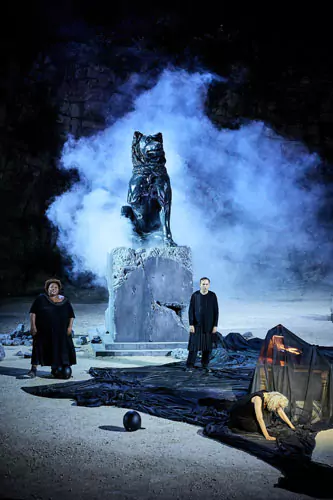
Photo credit: Christophe Raynaud de Lage.
Leaving the cour d’honneur to Liddell, the Festival’s Artistic Director, Tiago Rodrigues, presented his new play, Hécube, pas Hécube, in the Boulbon rock quarry 17 km down river, a space which first served for Peter Brook’s Mahabharatta in 1985. Rodrigues wrote the play for and with the actors of the Comédie Française which here returns to Avignon for the first time in eight years.
I was apprehensive about the play. I’d read that it concerned an actress rehearsing the title role of Euripides’ Hecuba while also seeking justice for her autistic son who’d been mistreated at a state institution. (A similar scandal rocked Switzerland in 2011.) It’s an intriguing premise for a play, but there are several ways it could go wrong.
First, it’s very hard to add pathos to Hecuba. The queen of Troy has lost her husband, her rank, and her freedom. She’s watched her city burn. Reduced to slavery by the Greeks, she’s informed that one of her last surviving daughters is to be sacrificed on Achilles’ tomb. Later, she learns that her son has been murdered by the authorities to whose care she’d entrusted him.
Euripides’s Hecuba, like his Trojan Women, is set at the land’s end of human suffering. Hecuba’s pain is maximal, it supports no theatrical amplification or substitution. Anybody who thinks they can add to Hecuba’s plight by adding a subplot hasn’t fully imagined her pain or, worse, has no confidence that the audience can imagine it.
In the second case, they’ll set about ‘fixing’ a play that isn’t broken. They’ll add some additional affliction or bring the whole thing up to date by setting it in Gaza or South Sudan. Because otherwise the audience won’t get it, Patroclus needs to die of covid. Icarus needs to perish in a traffic accident.
This kind of thinking negates the whole enterprise of theatre. While we might hear Hamlet’s “what’s Hecuba to him or he to Hecuba that her should weep for her” quoted in justification, prince Hamlet, as a man of the theatre, would have no patience with such updates. Hamlet is grateful that the player king can weep. If Hamlet didn’t have so much on his mind, he’d weep, too—and feel better for it.
Alternatively, a playwright might attempt to hedge Hecuba’s colossal stock of grief, begging a few tears for another cause or another character in an analogous situation. This enterprise is likewise fraught with danger: if the analogy is apt, the cause or the character should be able to elicit sympathy without help from Hecuba. If the analogy doesn’t hold, the cause or character will appear trivial beside those of the ancient queen, a hangnail posing as an amputation.
As concerns Hécube, pas Hécube, my fears proved unjustified: Tiago Rodrigues has an intricate view of the relationship of art and life and a nuanced understanding of the interplay of real and imagined experience. His main character, an actress identified merely as “Nadia,” struggles in rehearsal. She has to leave early to make a court date, something not all of her castmates are ready to forgive. Her real-life struggle against a corrupt and indifferent health care system doesn’t lead her to empathy with a bronze-age queen seeking justice from the conquering Greeks. Her offstage problem experience doesn’t deepen her art. On the contrary, it’s a nuisance. It disrupts her relations with the other actors. In Rodriques’ play, reality is art’s parasite.
He’s also recruited a company of ace actors to play a company of ace actors stumbling toward an opening. They quarrel, they critique their costumes, they question the director’s choices and the décor’s meaning. These actors, like the actors they play, know the ropes. Over the course of the evening, Elsa Lepoivre depicts the Nadia’s struggle and Hecuba’s outrage coiling around each other like copulating snakes. Denis Podalydés plays a sceptical-but-later-sympathetic Agammemnon and doubles as the sceptical-but-later-sympathetic prosecutor. Loïc Corbery plays an abrasive actor playing the quick-witted villain, Polymestor. He doubles as the abrasive-but-quick-witted Minister of Health who defends the children’s home where the abuse took place. Séphora Pondi is a maid in the old play, Nadia’s lawyer in the framing action, and one of the accused abusers. The entire company pops in and out of Euripidies’ high-flown rhetoric as Rodrigues shuffles the stories together like playing cards. The old cliché is entirely absent. Life doesn’t suddenly rescue the stumbling artist, rather, it’s art that comes to life’s rescue: Hecuba makes Nadia a better litigant.
Designer Fernando Ribeiro supplies an enormous piece of archaic sculpture that towers over the actors’ rehearsal table. Rui Monteiro throws light all around the quarry as needed. Jose Antonio Tenente’s costumes are understated enough to work in both worlds. Everything is black in different degrees of gloss—even the actors’ water bottles.
With this production, the Comédie Française scores a triumphant return to Avignon.
Absalom, Absalom!
Séverine Chavrier’s Absalom, Absalom! distinguishes itself by its intricate scenography comporting several giant surfaces on which videos of the actors are projected in real time as they perform in a variety of on-stage spaces including two cars (rigged out with electric motors) a scaffolding, a miniature house and several hidden spaces we only see in video. There’s a microphone stage right where an actor plays the guitar and sings. Occasionally a turkey or a dog will run across the stage. These animal cameos add to a very busy visual environment.
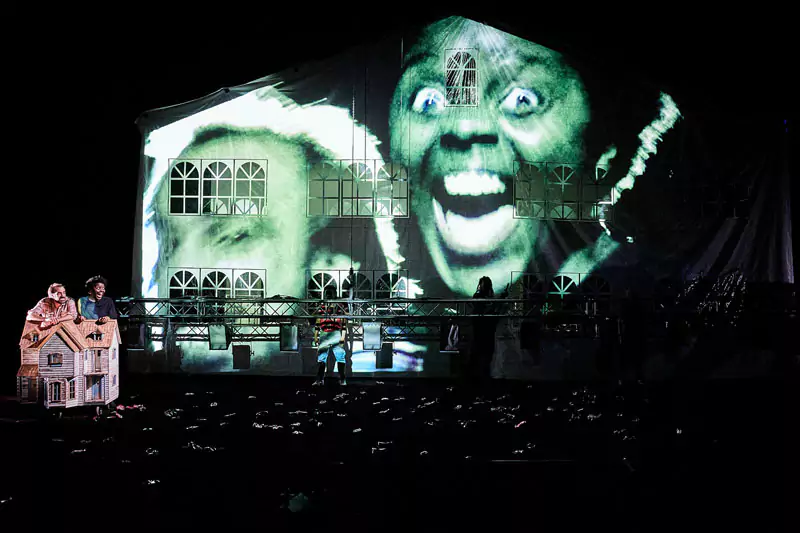
Photo credit: Christophe Raynaud de Lage.
It comes off as Chavrier’s ambitious (and expensive) attempt to merge theatre and film. For reasons I’ll discuss in a minute, it’s hard to judge the potential of her approach. To date, the most successful application of filmic techniques to theatre I’ve seen is Ariane Mnouchkine’s Ephémères, a production which used no cameras and no screens; it simply moved actors and scenery past the audience with the fluidity and grace you’d expect of expert cinematography.
In an interview, Chavrier claims her setup is immersive. I disagree. Immersion is fundamentally a state of imagination. Techniques which seek to co-opt or replace imagination repel the audience. In Absolom, Absolom! the result is not immersion but submersion; we drown in sensory stimuli of which we can make no sense. Chavrier’s elaborate real-time projection scheme only ensures that scenes can be badly played and badly filmed at one and the same time. On screen, the actors are grotesque, their performances overblown, their timing given over to unseen cameramen and editors who cut frantically from face to face as if immobility of image were death itself.
If you try to ignore the screens and look directly at the actors, you don’t see much. When they’re visible at all, the actors are far upstage or sitting in cars, their performances aimed at cameras, not at the audience.
The play’s incoherence also alienates. Chavrier composed her text from actor’s improvisations based on their impressions of William Faulkner’s 1936 novel. Most of them re-position the action in the USA of the present day. Scenes (or should I call them “shots”?) display all the usual faults of improvisational theatre. Shapeless and drawn-out, their focus is often disputed by actors with divergent notions of what the scene is meant to accomplish. Motivations are hard to find. To compensate, actors perform break dances and adlib in weirdly accented English. As these digressions pile up, Absolom, Absolom! runs five hours with two intermissions.
It will be argued that the novel is likewise turgid, repetitive and obscure, but the novel had a single creative intelligence behind it. Its obscurity—and its stunning flashes of clarity—were planned. Yes, the novel has multiple narrators, not all of them reliable, but they’re all trying to tell the same story. It’s not clear if Chavrier’s actors read the novel carefully—or at all.
Details don’t much matter here: the American Civil War is conflated with the two world wars and Vietnam, Confederate soldiers listen reverently to the Star-Spangled Banner, a crucial dispute in the novel on Christmas day falls on Halloween in the play; Quentin’s Harvard dorm room in 1912 is full of modern French paperbacks, foreign beer cans, a crucifix and an electronic scale for weighing amphetamines.
Adèle Joulin, playing Miss Rosa sticks fairly closely to the character in the novel even as she makes coy references to the screen that co-opts her narration to Laurent Papot playing young Quintin. When Papot doffs his “Harvard” tee shirt, however, he doubles as Thomas Sutpen, the central figure of the novel, whom he reduces to a blowhard, a compulsive talker, a redneck loser, exactly the sort of person who never gets anything done. Yet in the novel we never hear Sutpen’s voice at all. He has no dialog. He’s defined entirely by his accomplishments and force of will.
Faulkner’s novel lays out the rigid and unforgiving social codes of the anti-bellum South when respectability and caste were everything. Chavrier’s play bathes in an MTV version of low-life America. It’s the rec room of a drunken trailer park, full of sound and fury, signifying nothing.

